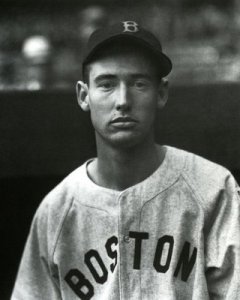
(Note: This article was published by the author on another Red Sox web site prior to the establishment of this site.)
One cannot talk about the history of the Red Sox without included one of the most prominent figures in its history, Theodore Samuel Williams. Known as the Splendid Splinter, the Thumper, the Kid, and the self-proclaimed Greatest Hitter That Ever Lived, he was just a boy from San Diego who loved to swing a bat. With his mighty swing, he stormed through the record books and left behind marks that may never be reach again.
Besides being the last man to hit .406, he also had a lifetime on-base percentage of .482, best in the history of the game. He also had a slugging percentage of .634 (2nd), a career batting average of .344 (7th), 2654 hits, 2021 walks, 1798 runs, 1839 RBI, and 512 home runs, numbers that would be even more impressive, if not for the fact that he gave up nearly five years of his career to military service. He also won not one but two batting Triple Crowns, a feat that was last accomplished by another Red Sox legend, Carl Yastremski, in 1967.
As I never got to see him play (I was not born until nearly 12 years from the day he retired), I have only film reels, pictures, and reference material to teach me all there is to know about his baseball career. But there was more to the man as demonstrated by his commitment to his country in time of war when he could have opted to let his baseball career exempt him from service. It even happend during the prime of his career; his stint in World War II came just after completing his 1942 Triple Crown campaign. He also played a significant part in raising money for the Jimmy Fund, an organization he championed on behalf of former owner Tom Yawkey, to help support cancer research. He also made baseball realize that the Hall of Fame should recognize the records of those who played in the Negro Leagues of the past during his acceptance speech to the baseball shrine in 1966.
My one true memory of him will always be when he came onto the field to throw out the first pitch prior to the 1999 All-Star game. As he was carted onto the field to make what would be one of his last public appearances, he tipped his cap to the crowd, something he did not do when he homered in his final career at-bat in 1961. When he came to the center of the diamond, he was immediately surrounded by players past and present, those there to participate in the contest, and those who had been introduced on the All-Century team as Ted had. It was a magical scene that left not a dry eye in the house, not if you understood the significance of some great ballplayers of the present paying respect to arguably the greatest hitter who ever lived.
It will be hard to imagine that someone else will come along and make Williams look mortal in comparison. Williams stood tall in his time and he stands tall by today’s standards. Though he is gone now, it is not likely that he will be forgotten; even years from now, he will stick around in the hearts and minds of those who love the game of baseball.